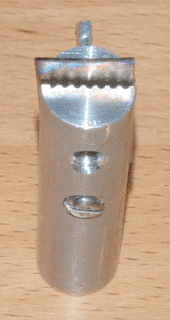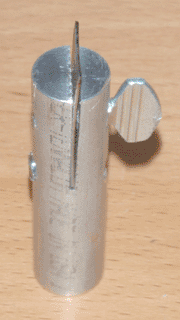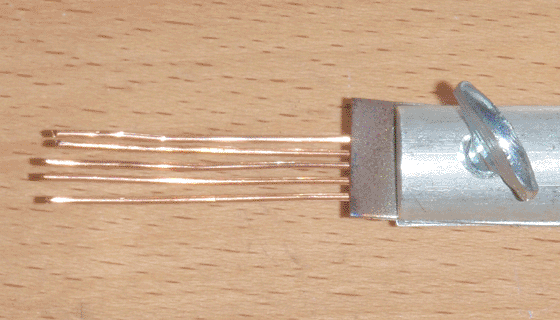


For the pinch seals of previous vacuum tubes, I spot welded the feedthroughs together into a hairpin-shaped bundle before fusing them into the glass. This required no special equipment, but wasted material in the weld area and often produced crooked feedthroughs, since they were only held in place by the glass itself during the sealing process. As an improvement, I built a wire holder so that feedthroughs could be assembled and used independently, and be held rigidly while the seal is being made. It was inspired by Ron Soyland's wire holder, which has a similar design.
I started with a 2 inch length of 1/2 inch aluminum rod, into the end of which I drilled seven 1mm holes. I then drilled and tapped the holes for the tightening screws, and used a 1/32 inch slotting saw to turn the holes into troughs. The slot also provides room for a piece of sheet steel, which is pressed against the feedthroughs to hold them in place. In practice, this is somewhat tricky to adjust, and it is difficult to get equal pressure on 3 or more feedthroughs. I will most likely develop an improved version of this fixture in the future.
Making seals in Pyrex is, in a sense, just a more extreme version of making seals in soft glass. Instead of titanium, tungsten is used to create a hermetic seal, since it has a similar coefficient of expansion (4.3ppm/°C) to Pyrex (3.3 ppm/°C). Like titanium, it must first be sanded or ground to a bright finish, but unlike titanium it should then be flashed briefly to a white heat to drive out any trapped air. The sealing process is similar as well, but with tungsten the glass should be brought to a white heat after making the initial pinch, so that it becomes liquid and dissolves the thick oxide layer formed during the previous step. The finished seal should be golden brown and slightly metallic, indicating a thin layer of tungsten oxide between the metal and the glass. The results of this process can be seen below. The feedthroughs are made of 0.8mm nickel, with 0.5mm tungsten being used for the seal area.

